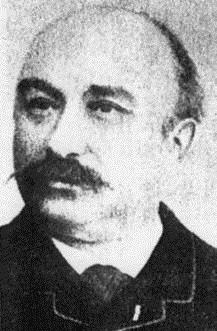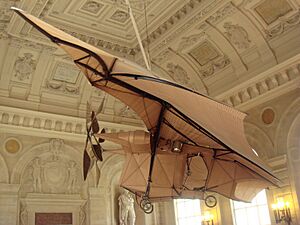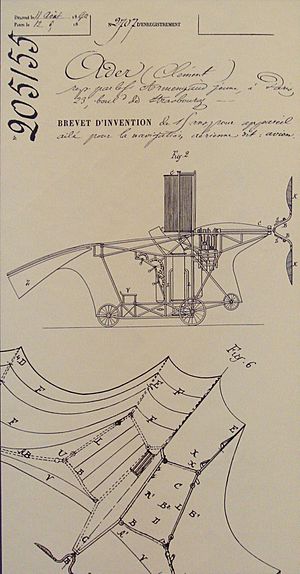Clément Ader facts for kids
Quick facts for kids
Clément Ader
|
|
|---|---|
 |
|
| Born | 2 April 1841 Muret, Haute-Garonne, France
|
| Died | 3 May 1925 (aged 84) |
| Nationality | French |
| Occupation | Engineer |
| Engineering career | |
| Discipline | |
| Projects |
|
| Significant design |
|
| Significant advance | First self-propelled flight (1890) |
Meet Clément Ader (born April 2, 1841 – died May 3, 1925), a brilliant French inventor and engineer. He was born in Muret, near Toulouse, and later passed away in Toulouse. Ader is best known for his amazing work in early aviation, which means building and flying aircraft. He also helped start the sport of cycling in France in 1870.
Contents
Clever Inventions: Electricity and Machines
Clément Ader was very creative in both electrical engineering and mechanical engineering. He first studied electricity. In 1878, he made improvements to the telephone, which had been invented by Alexander Graham Bell. After this, he helped set up the telephone system in Paris in 1880.
In 1881, Ader invented something called the théâtrophone. This was a special telephone system. It let listeners hear sound from two separate channels, one for each ear. This made the sound seem much more real, almost like being there! It was the first time opera performances were sent in stereo over a distance of 3 kilometers (2 miles). Later, in 1903, he designed a powerful V8 engine for a car race. However, these engines were never sold.
Early Flying Machines

After working on engines, Ader became very interested in how to make machines fly. He spent a lot of his time and money on this goal. He studied how birds fly, especially the work of Louis Pierre Mouillard. In 1886, Ader built his first flying machine, which he called the Ader Éole.
The Éole looked a bit like a giant bat. It was powered by a special lightweight steam engine that Ader invented himself. This engine had 4 cylinders and produced 20 horsepower. It turned a four-bladed propeller. The whole machine weighed about 300 kilograms (660 pounds), and its wings stretched 14 meters (46 feet) wide.
On October 9, 1890, Ader tried to fly the Éole. Many aviation experts believe this was the first time a self-powered machine took off from the ground. The Éole made a short, uncontrolled hop of about 50 meters (164 feet). It flew very low, only about 20 centimeters (8 inches) off the ground, staying in what's called "ground effect." Ader himself also said he got off the ground with the Éole.
Ader then started building a second aircraft, the Avion II. It was also known as the Zephyr or Éole II. Most people agree that this aircraft was never fully finished. Ader later claimed he flew the Avion II for 100 meters (328 feet) in 1892. However, this claim was not widely accepted.
Ader's work caught the attention of the French Minister of War, Charles de Freycinet. With support from the French army, Ader built his third aircraft, the Avion III. This machine also looked like a huge bat, made from linen and wood. It had a wingspan of about 14.6 meters (48 feet). The Avion III had two four-bladed propellers, each powered by a 30-horsepower steam engine.
On October 12, 1897, Ader tested the Avion III on a circular track. Two days later, he tried to fly it. After a short run, a gust of wind pushed the machine off the track, and it stopped. After this, the French army stopped funding his work. The results of his flights were kept secret until 1910, when official reports stated they were not successful.
A Book About Flying
Clément Ader continued to support the development of aviation. In 1909, he published a very popular book called L'Aviation Militaire (Military Aviation). This book was reprinted 10 times before the First World War. It was amazing because Ader wrote about what air warfare might be like in the future. He also described what a modern aircraft carrier would look like. He imagined a ship with a flat flight deck, a control tower (called an "island superstructure"), elevators for aircraft, and a hangar bay.
His ideas for an aircraft carrier were shared with the United States Navy. This led to the first trials of aircraft landing on ships in the US in November 1910.
An airplane-carrying vessel is indispensable. These vessels will be constructed on a plan very different from what is currently used. First of all the deck will be cleared of all obstacles. It will be flat, as wide as possible without jeopardizing the nautical lines of the hull, and it will look like a landing field.
—Clément Ader, L'Aviation Militaire, 1909
His Lasting Impact


Clément Ader is still admired for his early efforts in powered flight. In fact, his aircraft gave the French language the word avion, which means a heavier-than-air aircraft (like an airplane).
In 1938, France honored him with a special postage stamp. Airbus, a famous aircraft company, named one of its assembly sites in Toulouse after him. Clément Ader is often called "the father of aviation" because of his pioneering work.
Images for kids
See also
 In Spanish: Clément Ader para niños
In Spanish: Clément Ader para niños




